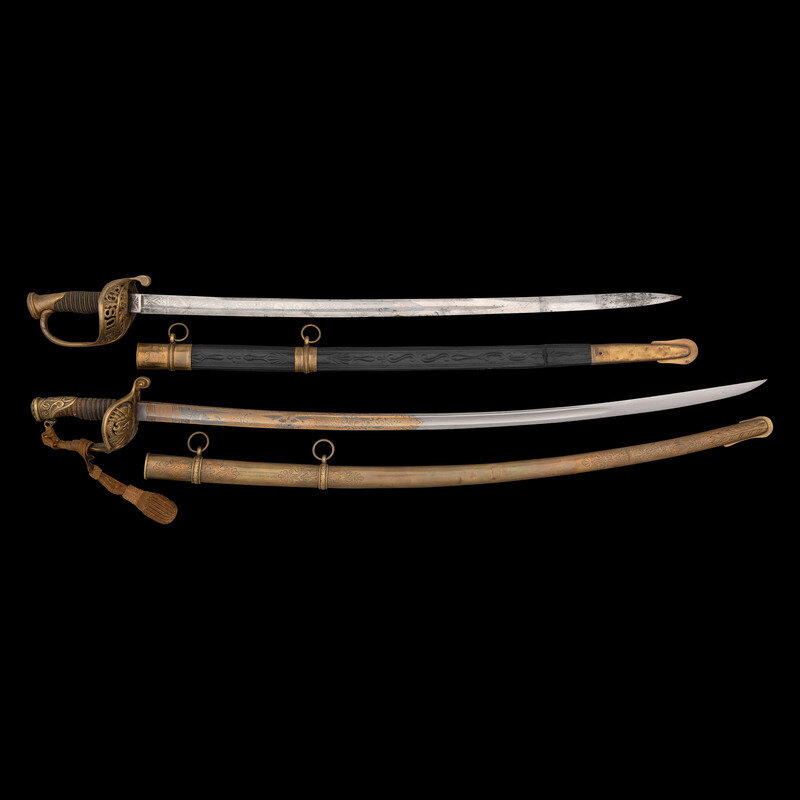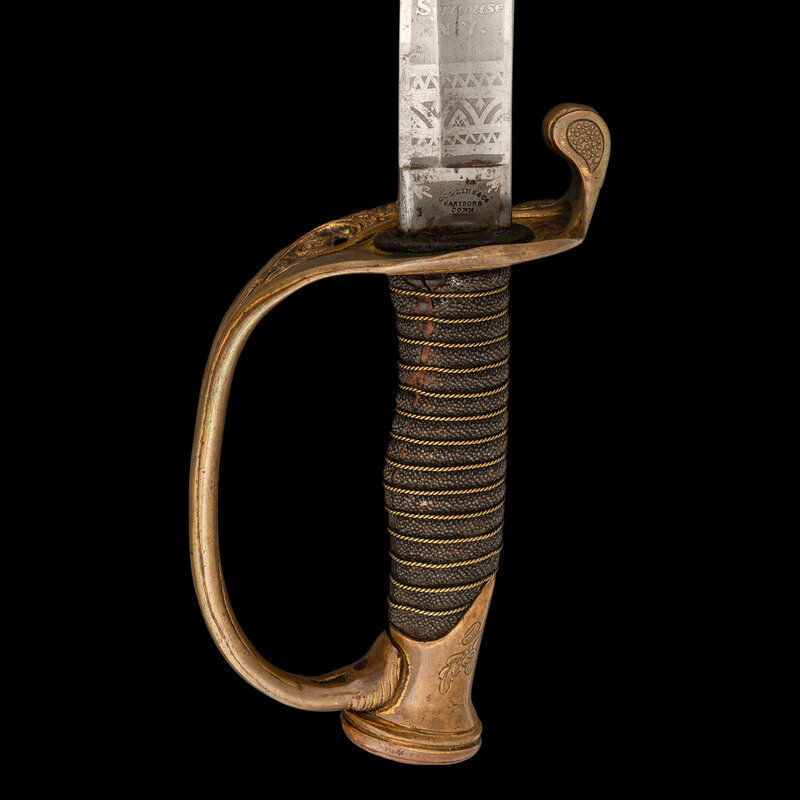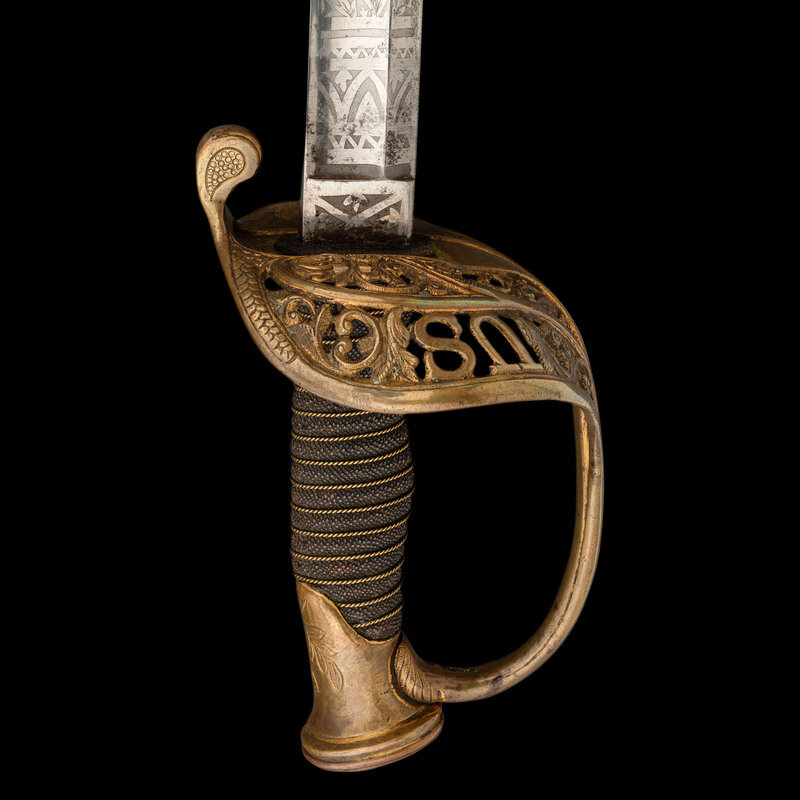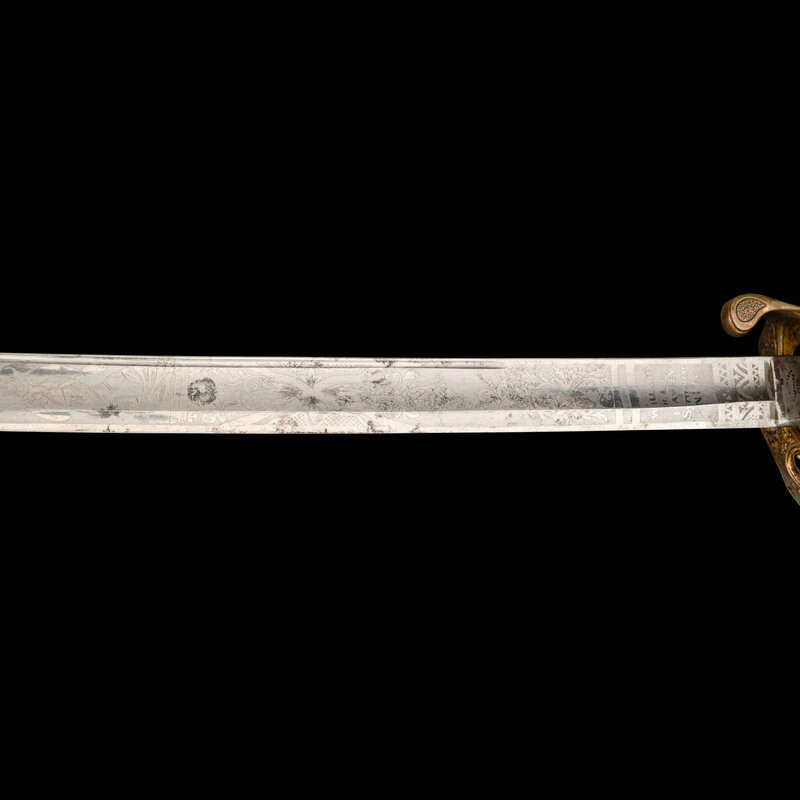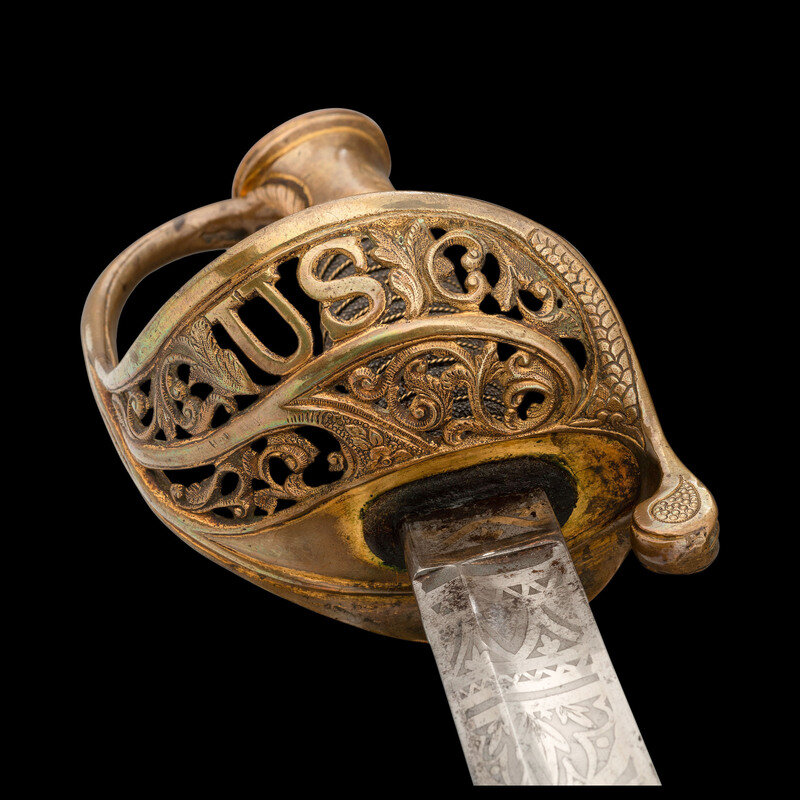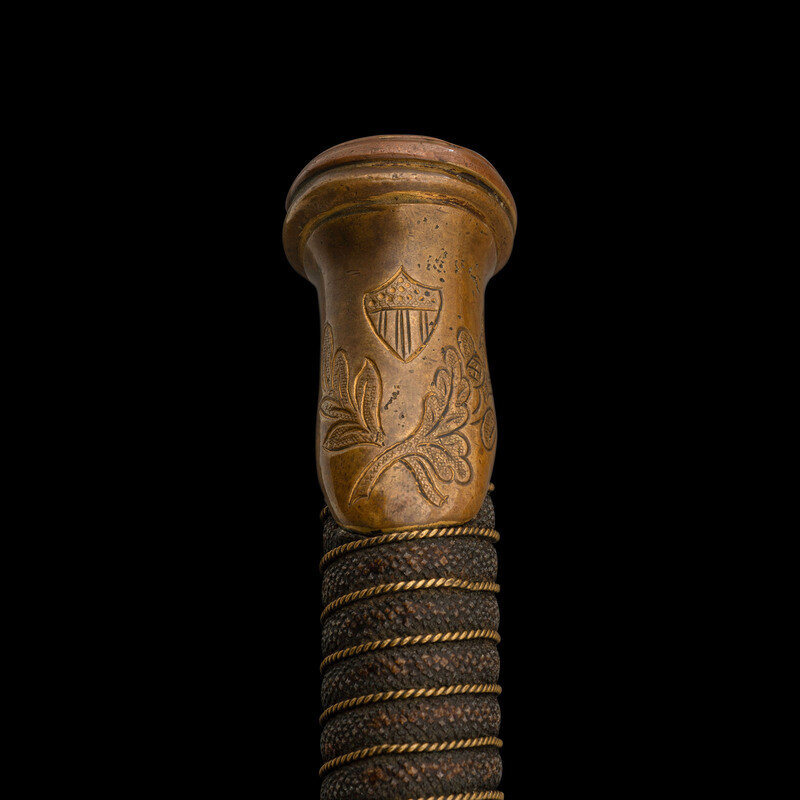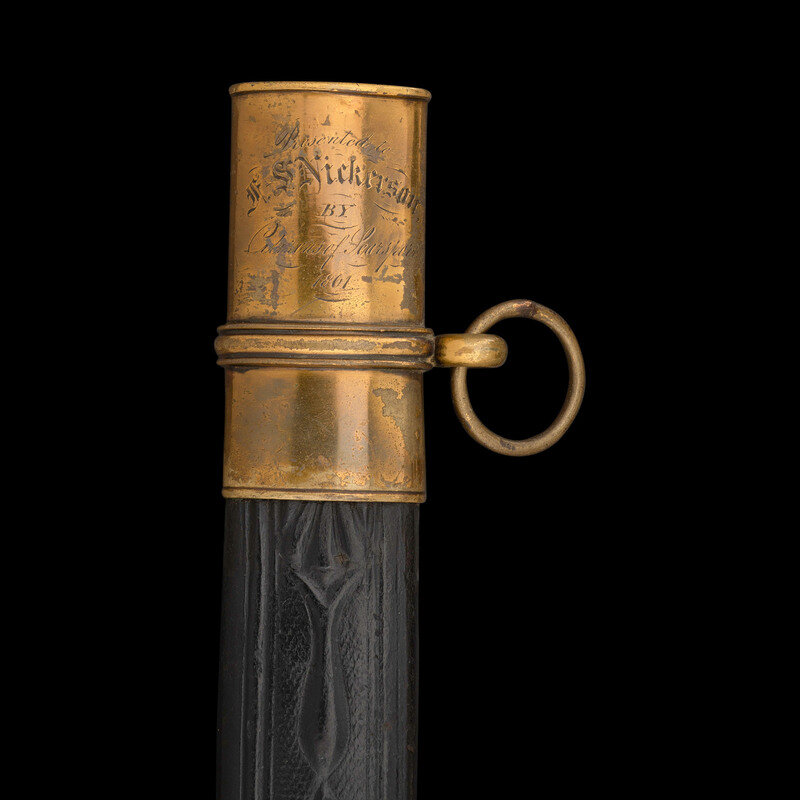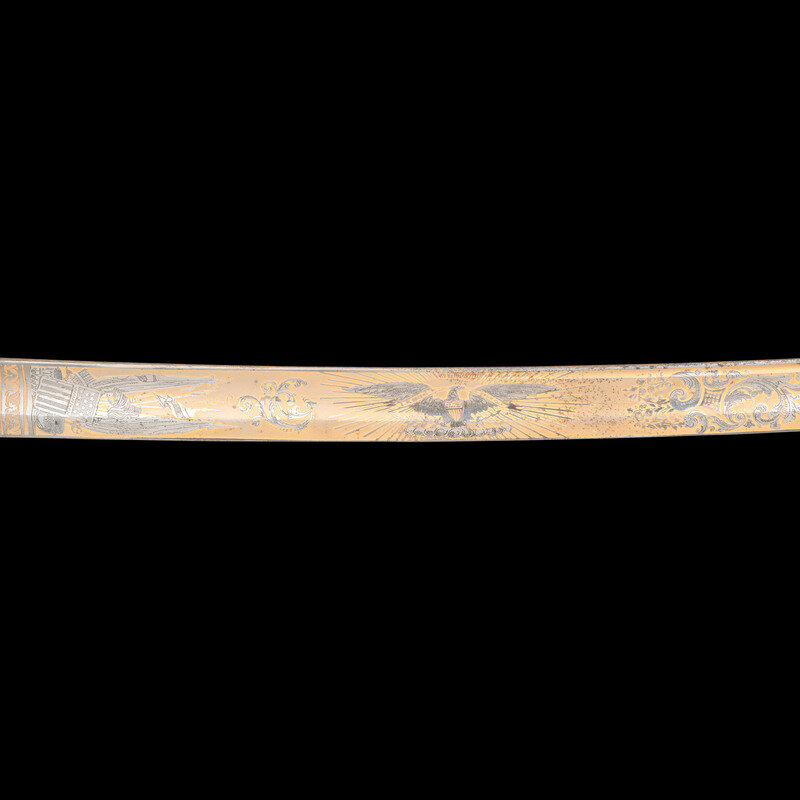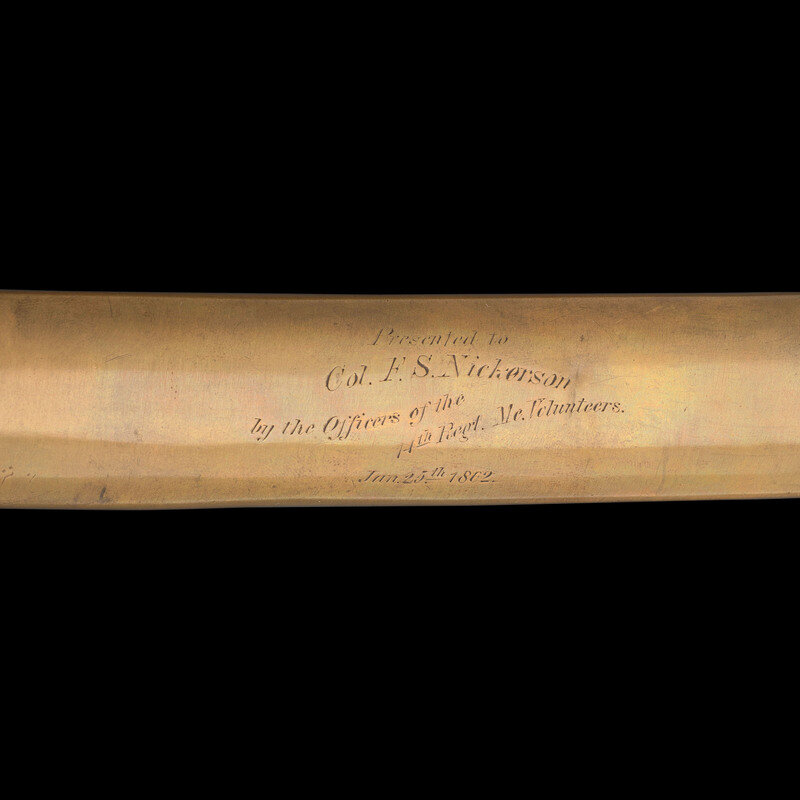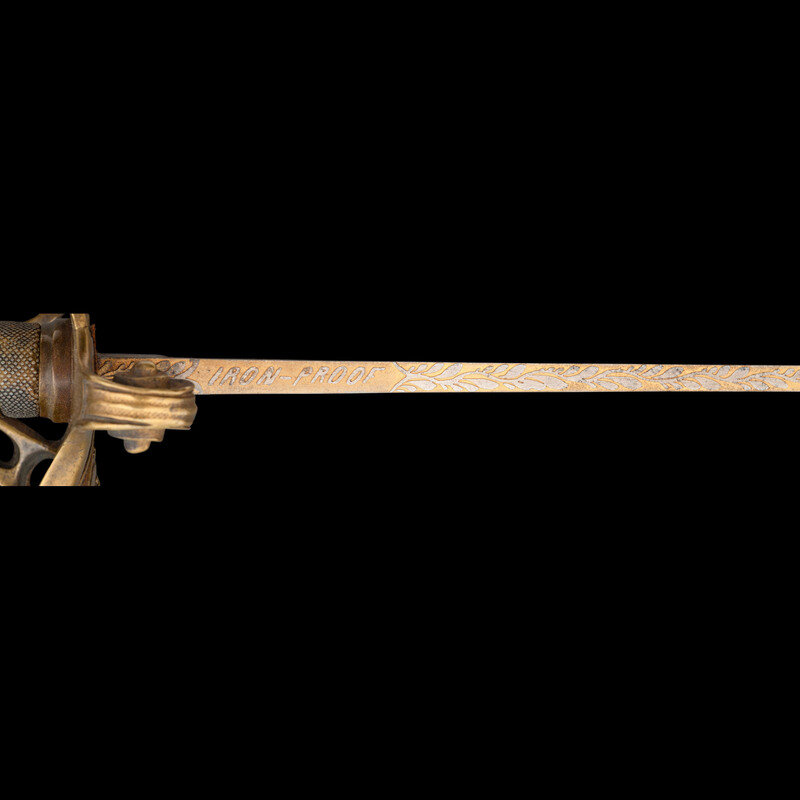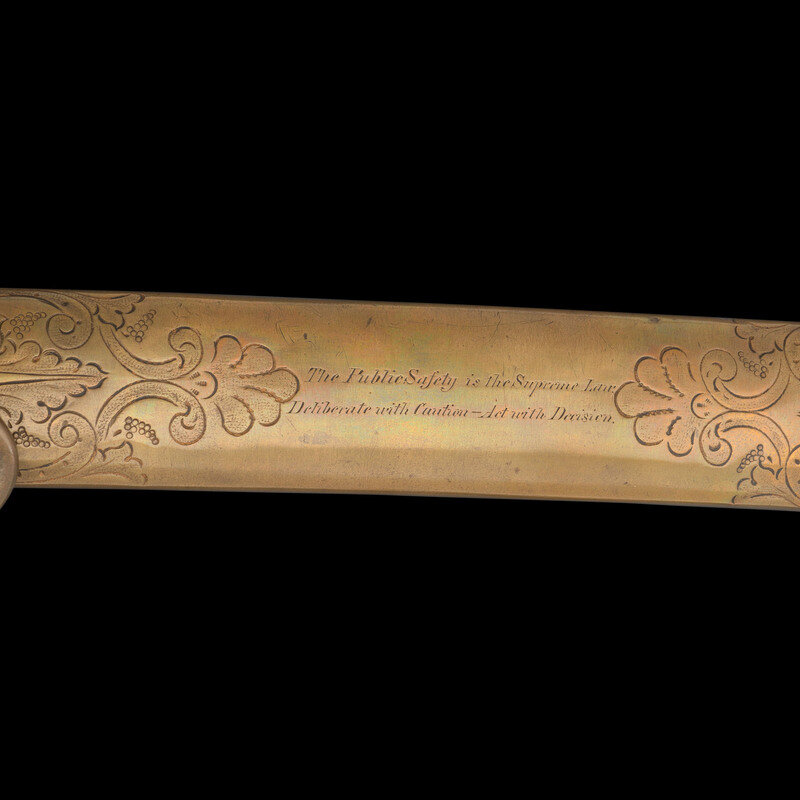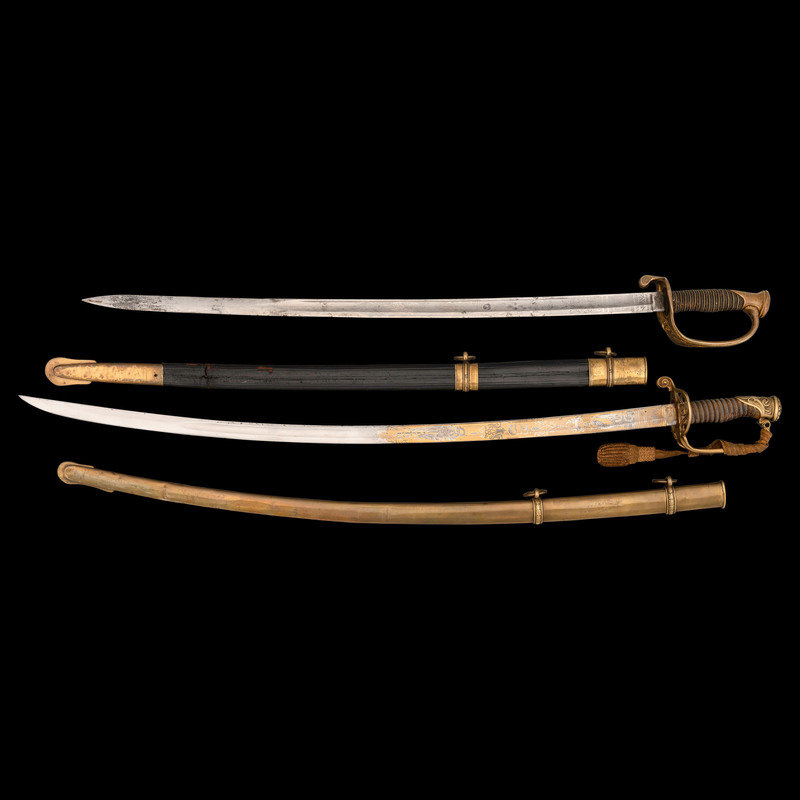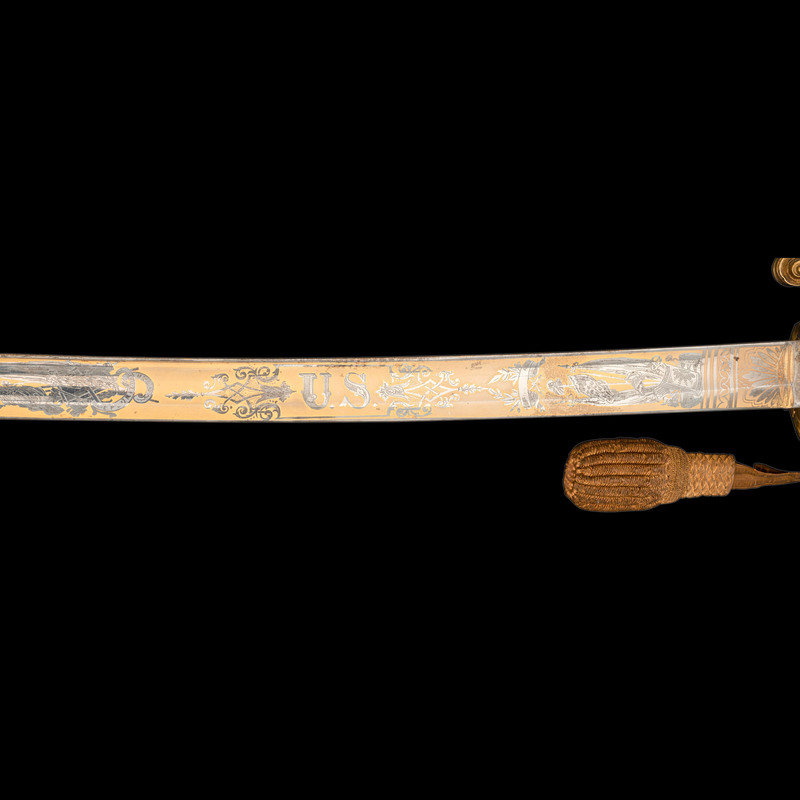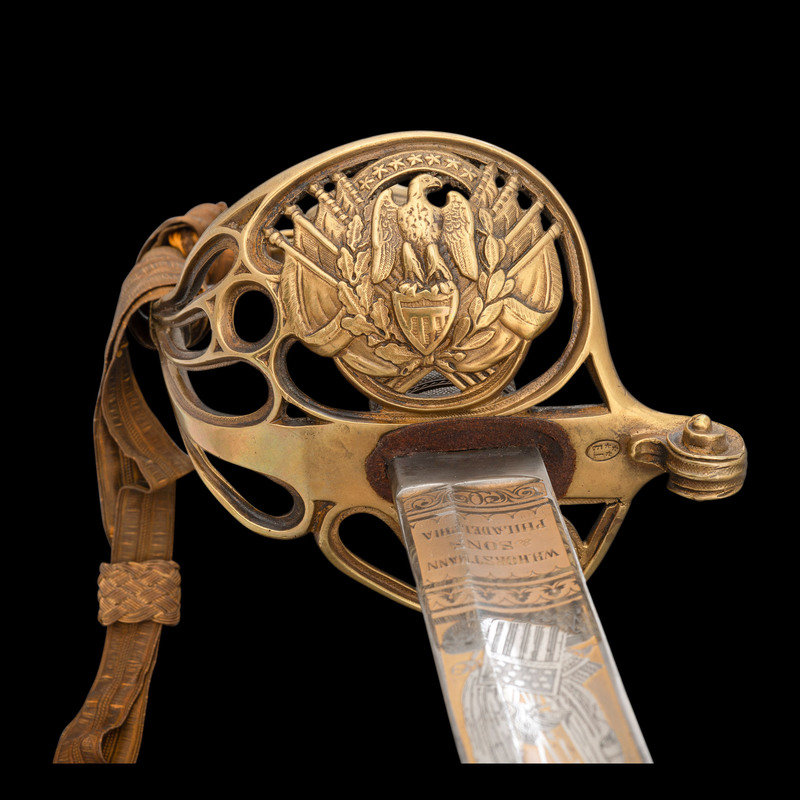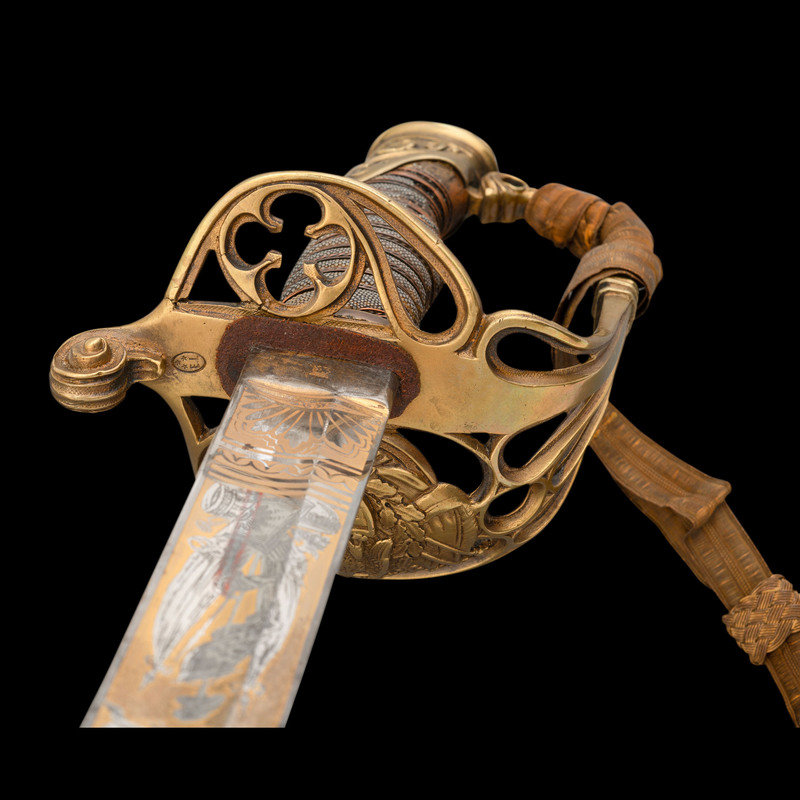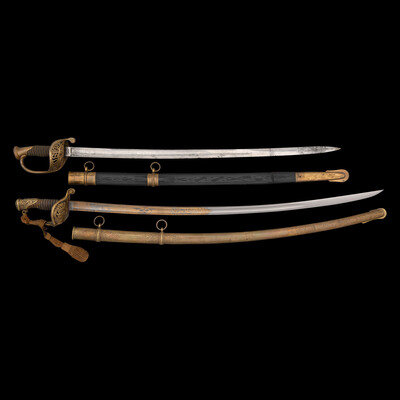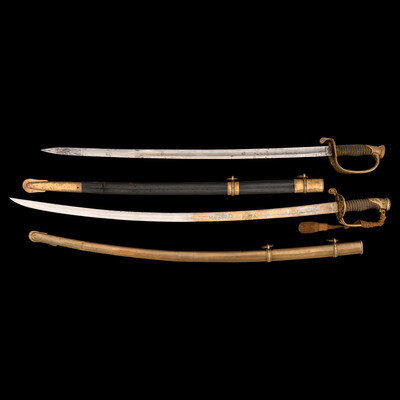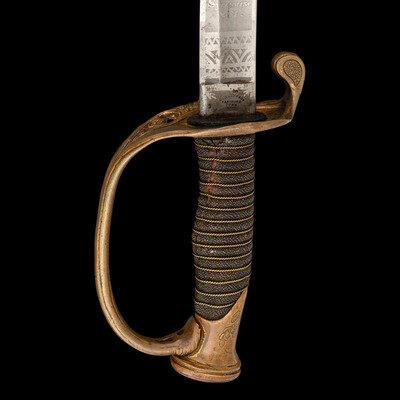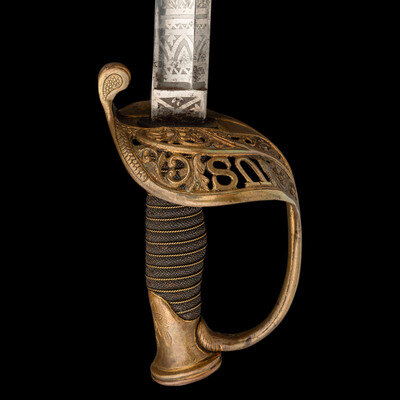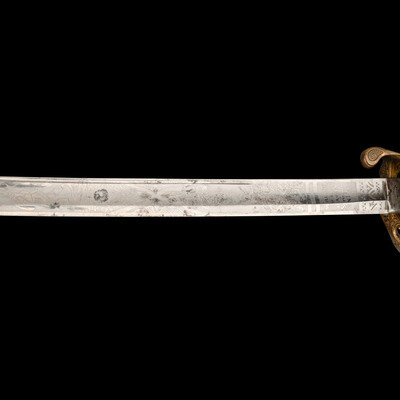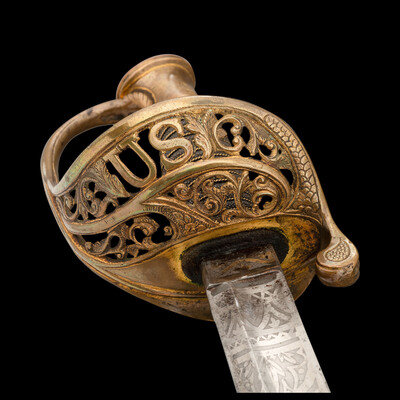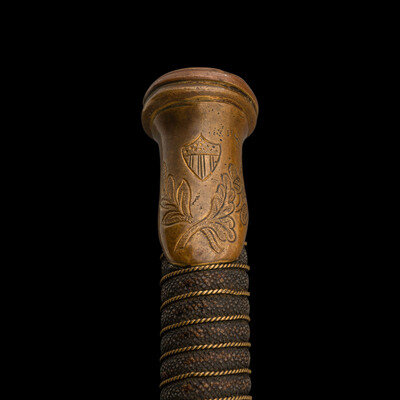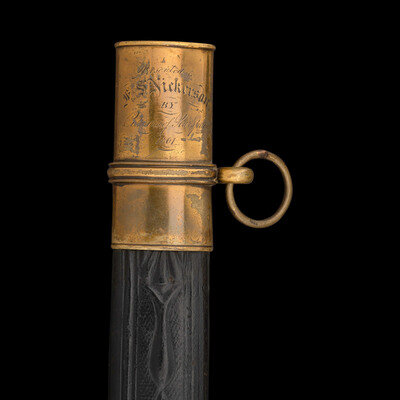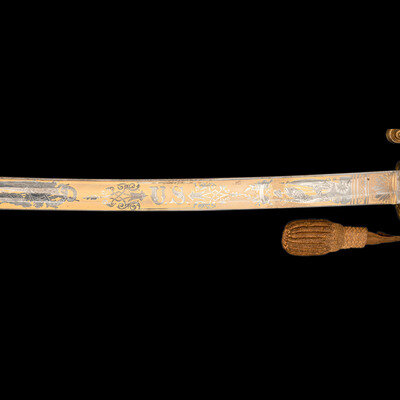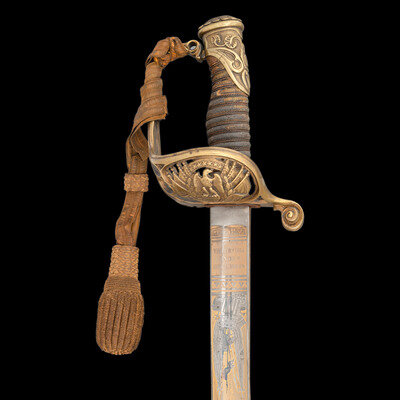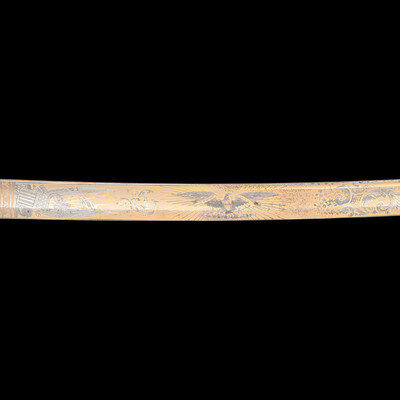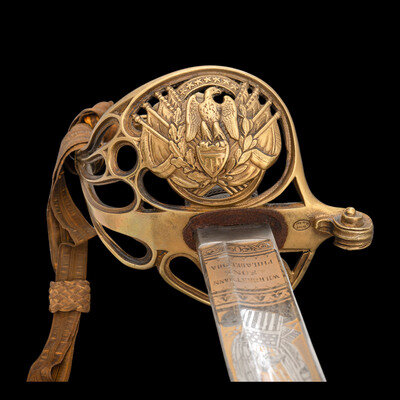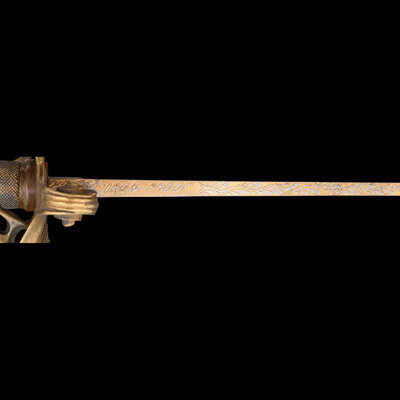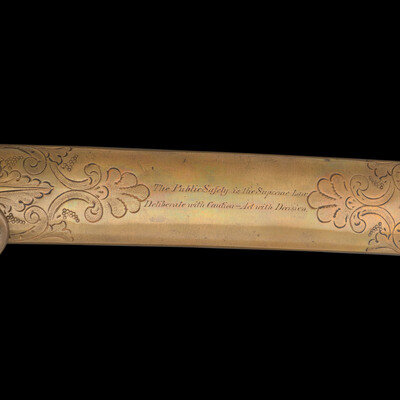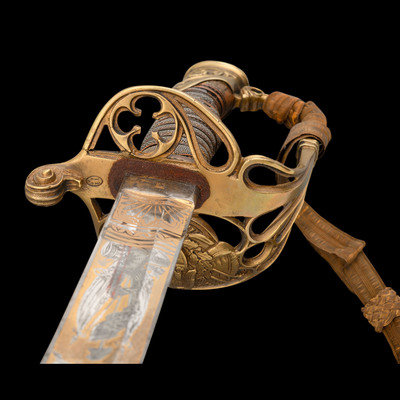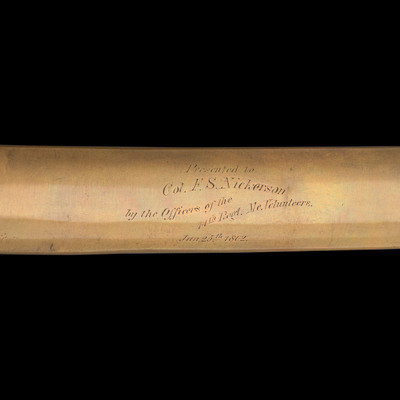Lot of Two Model 1850 Staff and Field Officer's Swords of General Franklin S. Nickerson
Sale 1293 - Arms, Armor & Militaria
Oct 24, 2023
10:00AM ET
Live / Cincinnati
Own a similar item?
Estimate
$8,000 -
12,000
Price Realized
$9,600
Sold prices are inclusive of Buyer’s Premium
Lot Description
Lot of Two Model 1850 Staff and Field Officer's Swords of General Franklin S. Nickerson
American Civil War
1.) 30.9" blade length. 37.5" overall with scabbard and hilt. Single edged blade with slight curve and spearpoint tip in addition to double fullers. The sword mounts a brass guard with shagreen handle secured by brass wire. An etched dealer mark on the left blade reads WILLARD/"&"/HAWLEY/Syracuse/N.Y., while the ricasso is stamped with the maker mark C. COLLINS & CO/HARTFORD/CONN. Blade has been etched with floral designs enclosing U.S. on the right blade and UNION within a banner on the left. The hilt features a peened tang with Eagle design on the pommel cap, the US Army Shield above olive leaves on the upper pommel, and US within oak leaf details. The scabbard features a tooled leather body with brass mountings. The throat has been hand engraved Presented to/F.S. Nickerson/BY/Citizens of Searsport/1861.
2.) 34.75" blade length. 41" overall with scabbard and hilt. US Model 1850 Staff and Field Officer's Sword featuring a single edge curved blade with double fullers and a spearpoint tip. Both sides of the blade are decorated with etched patterns within a gilt ground. The right blade shows the etched marking W.H.HORSTMANN/& SONS/PHILADELPHIA. along with an IRON-PROOF mark along the back of the blade. The forward face of the guard bears the marking {Triple stars/EL}, while the left ricasso bears a German {King's Head} maker mark of Gebruder Weyersberg. The blade has been etched with stylized U.S. mark within a banner on the left blade below a further banner marked E PLURIUS/UNUM. The right blade displays a {US Army Eagle} above a sunburst clutching a banner in its beak with the national motto E PLURIBUS UNUM repeated on it. Further floral embellishments flow along the back of the blade. The hilt features a prominent US Army Eagle motif on the right guard with cast palm leaf designs on the pommel and a shagreen wrapped wood core. A sword knot with ribbon is affixed to the guard. The brass scabbard accompanying the sword features floral and leaf scroll embellishments surrounding the mountings and has been engraved on both sides between the loops. The obverse side bears the motto The Public Safety is the Supreme Law/Deliberate with Caution-Act with Decision, while the reverse is marked Presented to/Col. F.S. Nickerson/by the Officers of the/14th Regt. Me. Volunteers/Jan. 25th 1862.
Franklin Stebin Nickerson was born on August 27, 1826 to Seth and Mary Nickerson in Swanville, Maine. Prior to the American Civil War, he read law in the office of his elder brother, an agent of the United States Custom Service. After Tuberculosis caused his brother's health to fail, Franklin took over his appointment as the Deputy Collector of Customs for the District of Searsport and Prospect. During this time, he became active in politics, and campaigned for the Wildcat faction of the Democratic Party in Searsport. As the United States slipped inexorably toward Civil War, Nickerson offered his vocal support for the Union, and backed it with decisive action when he enlisted on June 11, 1861. Owing to his education and previous experience with the militia, Nickerson was commissioned Major of the 4th Maine Volunteer Infantry Regiment. He then served with the 4th Maine through some of the first engagements of the Civil War, including the Battle of First Bull Run. During that engagement, he was specifically cited for gallantry by brigade commander Colonel O.O. Howard. Nickerson received his promotion to Lieutenant Colonel on September 9, 1861, and continued to serve with the 4th for a further two months. His time with 4th Maine drew to a close on November 25, 1861, when he was discharged for promotion to Colonel of the 14th Maine Volunteer Infantry. He would soon be transferred along with his unit to the Department of the Gulf under General Benjamin Butler.
Nickerson was presented with the second sword in this lot to celebrate his promotion and his new command. The occasion was reported by the Kennebec Journal's entry for February 7, 1862. The officers of the 14th Regiment presented Nickerson with "A beautiful horse with its entire military dress, a sword, epauletts and sash, together with a suit made at Dolliver's". His acceptance speech concluded with this note. "Gentlemen, I thank you for this manifestation of your kindness, and it shall be my endeavor so to discharge my duty in the future that you may never regret this offering."
In August of that year, he backed up his promise leading the 14th in repelling General John Breckenridge's attempts to throw back the Union forces in the Battle of Baton Rouge. For this, he was commended by General Benjamin Butler. Owing to his meritorious service, he received his promotion to Brigadier General November 29, 1862 and served as the commander of the Third Brigade, Second Division in the Department of the Gulf, but then his fortunes began to turn. The 14th was dispatched to participate in the disastrous Siege of Port Hudson, Louisiana. Though a Union Victory, Port Hudson did not surrender until after Vicksburg fell to Grant, and Federal losses during the battle far exceeded those of the Confederates. On May 27, 1863, the 14th Maine took part in a direct assault on Confederate positions surrounding Port Hudson, but the attack was repulsed by well-entrenched artillery and infantry. The open ground over which the Union forces charged was aptly named "Slaughter Field". During the assault, the divisional commander General T.W. Sherman was severely wounded, leaving Nickerson temporarily in command until relieved by General William Dwight. On the night of June 29, 1863, Nickerson led two regiments in an attack on the Confederate defensive position known as "The Citadel". The attack quickly turned into a fiasco owing to the overwhelming strength of the Confederate position and the poorly considered plan of attack. In July, Nickerson developed a serious case of Rheumatism, and went on medical leave to New Orleans, then returned home between October and December, 1863. According to those close to him, he walked with difficulty during this time, and required the use of a cane. But by December 29, he had healed enough to return to active duty.
Nickerson returned to Commanded his regiment during the Red River Campaign until he was recalled to Washington, D.C. in 1864, concluding his active command during the Civil War. He resigned in 1865, and returned to legal practice for the next forty years. During this time he was an active member of the G.A.R., though his health began to decline sharply by 1891. By 1901, he relied on constant help to attend to daily tasks. On the occasion of his 89th birthday in 1915, he was interviewed about the then ongoing Great War in Europe. The long retired Brigadier General was convinced that the Allies would win, but concluded with a warning reflecting the troublesome post-war experience of his own generation. "I would rather fight than have a hand in the settling up of affairs after the war is over. If the victor demands that the present boundary lines of the various countries be changed because of conquest, wars will continue indefinitely in the future. I believe that in the settlement boundaries should be left alone. That is the only hope for peace in the future." It was a future he did not live to see, as Franklin Nickerson died on January 23, 1917, and was entombed in the Forest Hills Crematory outside of Boston, Massachusetts.
2.) 34.75" blade length. 41" overall with scabbard and hilt. US Model 1850 Staff and Field Officer's Sword featuring a single edge curved blade with double fullers and a spearpoint tip. Both sides of the blade are decorated with etched patterns within a gilt ground. The right blade shows the etched marking W.H.HORSTMANN/& SONS/PHILADELPHIA. along with an IRON-PROOF mark along the back of the blade. The forward face of the guard bears the marking {Triple stars/EL}, while the left ricasso bears a German {King's Head} maker mark of Gebruder Weyersberg. The blade has been etched with stylized U.S. mark within a banner on the left blade below a further banner marked E PLURIUS/UNUM. The right blade displays a {US Army Eagle} above a sunburst clutching a banner in its beak with the national motto E PLURIBUS UNUM repeated on it. Further floral embellishments flow along the back of the blade. The hilt features a prominent US Army Eagle motif on the right guard with cast palm leaf designs on the pommel and a shagreen wrapped wood core. A sword knot with ribbon is affixed to the guard. The brass scabbard accompanying the sword features floral and leaf scroll embellishments surrounding the mountings and has been engraved on both sides between the loops. The obverse side bears the motto The Public Safety is the Supreme Law/Deliberate with Caution-Act with Decision, while the reverse is marked Presented to/Col. F.S. Nickerson/by the Officers of the/14th Regt. Me. Volunteers/Jan. 25th 1862.
Franklin Stebin Nickerson was born on August 27, 1826 to Seth and Mary Nickerson in Swanville, Maine. Prior to the American Civil War, he read law in the office of his elder brother, an agent of the United States Custom Service. After Tuberculosis caused his brother's health to fail, Franklin took over his appointment as the Deputy Collector of Customs for the District of Searsport and Prospect. During this time, he became active in politics, and campaigned for the Wildcat faction of the Democratic Party in Searsport. As the United States slipped inexorably toward Civil War, Nickerson offered his vocal support for the Union, and backed it with decisive action when he enlisted on June 11, 1861. Owing to his education and previous experience with the militia, Nickerson was commissioned Major of the 4th Maine Volunteer Infantry Regiment. He then served with the 4th Maine through some of the first engagements of the Civil War, including the Battle of First Bull Run. During that engagement, he was specifically cited for gallantry by brigade commander Colonel O.O. Howard. Nickerson received his promotion to Lieutenant Colonel on September 9, 1861, and continued to serve with the 4th for a further two months. His time with 4th Maine drew to a close on November 25, 1861, when he was discharged for promotion to Colonel of the 14th Maine Volunteer Infantry. He would soon be transferred along with his unit to the Department of the Gulf under General Benjamin Butler.
Nickerson was presented with the second sword in this lot to celebrate his promotion and his new command. The occasion was reported by the Kennebec Journal's entry for February 7, 1862. The officers of the 14th Regiment presented Nickerson with "A beautiful horse with its entire military dress, a sword, epauletts and sash, together with a suit made at Dolliver's". His acceptance speech concluded with this note. "Gentlemen, I thank you for this manifestation of your kindness, and it shall be my endeavor so to discharge my duty in the future that you may never regret this offering."
In August of that year, he backed up his promise leading the 14th in repelling General John Breckenridge's attempts to throw back the Union forces in the Battle of Baton Rouge. For this, he was commended by General Benjamin Butler. Owing to his meritorious service, he received his promotion to Brigadier General November 29, 1862 and served as the commander of the Third Brigade, Second Division in the Department of the Gulf, but then his fortunes began to turn. The 14th was dispatched to participate in the disastrous Siege of Port Hudson, Louisiana. Though a Union Victory, Port Hudson did not surrender until after Vicksburg fell to Grant, and Federal losses during the battle far exceeded those of the Confederates. On May 27, 1863, the 14th Maine took part in a direct assault on Confederate positions surrounding Port Hudson, but the attack was repulsed by well-entrenched artillery and infantry. The open ground over which the Union forces charged was aptly named "Slaughter Field". During the assault, the divisional commander General T.W. Sherman was severely wounded, leaving Nickerson temporarily in command until relieved by General William Dwight. On the night of June 29, 1863, Nickerson led two regiments in an attack on the Confederate defensive position known as "The Citadel". The attack quickly turned into a fiasco owing to the overwhelming strength of the Confederate position and the poorly considered plan of attack. In July, Nickerson developed a serious case of Rheumatism, and went on medical leave to New Orleans, then returned home between October and December, 1863. According to those close to him, he walked with difficulty during this time, and required the use of a cane. But by December 29, he had healed enough to return to active duty.
Nickerson returned to Commanded his regiment during the Red River Campaign until he was recalled to Washington, D.C. in 1864, concluding his active command during the Civil War. He resigned in 1865, and returned to legal practice for the next forty years. During this time he was an active member of the G.A.R., though his health began to decline sharply by 1891. By 1901, he relied on constant help to attend to daily tasks. On the occasion of his 89th birthday in 1915, he was interviewed about the then ongoing Great War in Europe. The long retired Brigadier General was convinced that the Allies would win, but concluded with a warning reflecting the troublesome post-war experience of his own generation. "I would rather fight than have a hand in the settling up of affairs after the war is over. If the victor demands that the present boundary lines of the various countries be changed because of conquest, wars will continue indefinitely in the future. I believe that in the settlement boundaries should be left alone. That is the only hope for peace in the future." It was a future he did not live to see, as Franklin Nickerson died on January 23, 1917, and was entombed in the Forest Hills Crematory outside of Boston, Massachusetts.
From the Collection of George Oldenbourg
Condition Report
Auction Specialists
